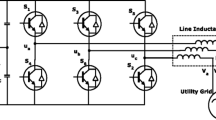Abstract
To avoid dealing with the zero dynamics limitation brought by the bidirectional power flow through the back-to-back converter in a doubly fed wind generator, a new energy-based modeling and control approach for the grid-side converter is presented. During the modeling process, the grid-side converter is divided into two subsystems with the feedback interconnection structure, and the interactive matrix of the model takes into account the concrete port structure. Then, an energy-based controller is proposed to realize the grid-side control objectives based on the new model. Simulation studies are carried out in MATLAB/Simulink. Comparative results between the proportional-integral controller and the energy-based controller show that the latter one can obtain faster convergence rate and global stability as the load current varies. Moreover, the energy-based controller is also competent for grid-side control when simulated in a 2 MW wind energy conversion system with random wind.
Similar content being viewed by others
References
A. D. Hansen, P. Sorensen, F. Lov, et al. Control of variable speed wind turbines with doubly-fed induction generators. Wind Engineering, 2004, 28(4): 411–434.
E. Tremblay, A. Chandra, P. J. Lagace. Grid-side converter control of DFIG wind turbines to enhance power quality of distribution network. IEEE Power Engineering Society General Meeting. Montreal: IEEE, 2006: 2233–2238.
Y. Jun, H. Li, Y. Liao, et al. An improved control strategy of limiting the DC-link voltage fluctuation for a doubly fed induction wind generator. IEEE Transactions on Power Electronics, 2008, 23(3): 1205–1213.
J. Jung, S. Lim, K. Nam. A feedback linearizing control scheme for a PWM converter-inverter having a very small DC-link capacitor. IEEE Transactions on Industry Applications, 1999, 35(5): 1124–1131.
J. Zhang, X. Li, G. Hou, et al. Study of sliding-mode control based grid-side PWM rectifier for wind power generation system under unbalanced input voltage condition. IEEE International Symposium on Industrial Electronics. Xi’an: IEEE, 2006: 1619–1624.
O. Soares, H. Goncalves, A. Martins, et al. Nonlinear control of the doubly-fed induction generator in wind power systems. Renewalbe Energy, 2010, 35(8): 1662–1670.
C. Batlle, A. Doria-Cerezo, E. Fossas. IDA-PBC controller for a bidirectional power flow full-bridge rectifer. IEEE Conferenct on Decision and Control. Seville, Spain: IEEE, 2005: 422–426.
J. Mendez, Y. Garcia, M. T. Mata. Three-phase power converter stabilization via total energy-shaping. IEEE Conference on Industrial Electronics and Applications. Singapore: IEEE, 2006: 1460–1465.
P. Wang, J. Wang, Z. Xu. Passivity-based control of three-phase voltage source PWM rectifiers based on PCHD model. IEEE International Conference on Electrical Machines and Systems. Singapore: IEEE, 2008: 1126–1130.
Y. Yang, H. Yu, Z. Zou. Hamiltonian modeling and energy-shaping control of three-phase AC/DC voltage-source converters. IEEE International Conference on Automation and Logistics. Qingdao: IEEE, 2008: 591–595.
R. Ortega, A. van der Schaft, I. Mareels, et al. Putting energy back in control. IEEE Control System Magazine, 2001, 21(2): 18–33.
R. Ortega, A. van der Schaft, B. Maschke, et al. Interconnection and damping assignment passivity-based control of port-controlled Hamiltonian systems. Automatica, 2002, 38(4): 585–596.
A. van der Schaff. L 2 -Gain and Passivity Techniques in Nonlinear Control. London: Springer-Verlag, 2000
Author information
Authors and Affiliations
Corresponding author
Additional information
This work was supported by the National Natural Science Foundation of China (No. 61074086), and the Fundamental Research Funds for the Central Universities (No. HIT. NSRIF. 2009145).
Huihui SONG was born in Heilongjiang, China, in 1983. She received her B.S. degree and M.S. degree from Harbin Normal University, China, in 2004 and 2007, respectively. She is currently working toward the Ph.D. degree at the Department of Electrical Engineering and Automation, Harbin Institute of Technology University, China. Her current research interests include nonlinear control theory and control technology in renewable energy.
Yanbin QU was born in 1961. He received his B.E., M.E., and Ph.D. degree in electrical engineering from Harbin Institute of Technology University, China. He is currently a professor and a doctoral supervisor of the Department of Electrical Engineering and Automation, Harbin Institute of Technology University. His background areas are control theory application, power electronics and electric drives; and his main current research areas are renewable energy and system control engineering.
Rights and permissions
About this article
Cite this article
Song, H., Qu, Y. Energy-based modeling and control for grid-side converter of doubly fed wind generator. J. Control Theory Appl. 10, 435–440 (2012). https://doi.org/10.1007/s11768-012-1052-4
Received:
Revised:
Published:
Issue Date:
DOI: https://doi.org/10.1007/s11768-012-1052-4




